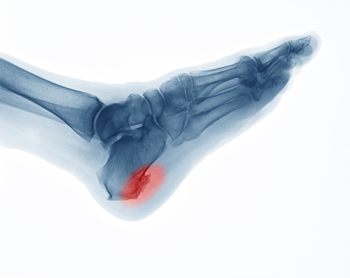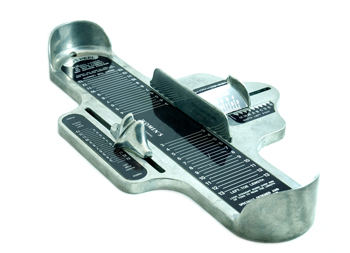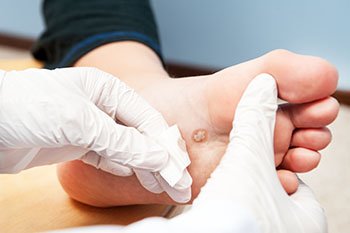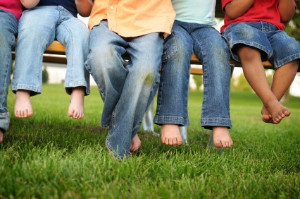Items filtered by date: August 2021
Buying Shoes That Feel Comfortable
By wearing shoes that fit well, you can prevent the development of many foot conditions such as bunions, corns, calluses, hammertoes, blisters, ingrown toenails, plantar fasciitis, Morton’s neuroma and more. Start by knowing your true size. You may think your feet are the same size as they were a few years ago, however, age, changes in weight, and other factors may cause your feet to grow and expand. Have your feet measured every time you buy shoes—both in length and width. Make sure you try shoes on at the end of the day, after your feet have expanded. Check for ⅜” to ½” of space between the tip of the shoe and your big toe, and that the ball of your feet don’t feel squeezed. Don’t buy shoes that feel uncomfortable thinking they will expand, or that you will wear them in later. Walk around the store for a while to get a real sense of their fit. Make sure you don’t slip around in them or that they cause friction by rubbing against your feet, toes, back of your heel, etc. If you are struggling to find the shoes with the right fit for you, a podiatrist can offer additional tips for buying shoes that are appropriate for your particular feet.
Getting the right shoe size is an important part of proper foot health. Seek the assistance of Dr. Douglas Mckay from New Jersey . Our doctor will provide the care you need to keep you pain-free and on your feet.
Getting the Right Shoe Size
There are many people who wear shoes that are the incorrect size, negatively affecting their feet and posture. Selecting the right shoes is not a difficult process, so long as you keep several things in mind when it comes to choosing the right pair.
- When visiting the shoe store, use the tools available to measure your foot.
- Be sure there is ‘wiggle room’. There should be about an inch between your toes and the tip of your shoes.
- Do not always assume you are the same size, as manufacturers run differently.
- Purchase shoes later in the day, as your feet swell as the day progresses.
- If a shoe is not comfortable, it is not suitable. Most shoes can’t be ‘broken in’, and comfort should be the ultimate goal when it comes to choosing the right pair of shoes
As our feet hold our body weight and keep us moving, it is important to treat them right. Picking the right pair of shoes can provide your feet comfort and mobility without pain.
If you have any questions, please feel free to contact one of our offices located in Caldwell, and Galloway, NJ . We offer the newest diagnostic and treatment technologies for all your foot care needs.
Stretching and Heel Spurs
 Patients who have developed heel spurs are often aware of the pain and discomfort they can cause. They can cause difficulty in pursuing daily exercise routines, and specific stretches may need to be incorporated that can possibly bring mild relief. A heel spur is defined as a bony growth that gradually develops and connects to the heel bone. It can develop as a result from standing on hard surfaces for most of the day, or from wearing shoes that do not fit correctly. Patients who are afflicted with heel spurs find it beneficial to stretch the calf muscles. This can strengthen the Achilles tendon, which connects the heel to the toes. It is practiced by standing on a step, and gently lowering one heel at a time. Additionally, relief from heel spur pain may be obtained from practicing a towel pickup. This is helpful in providing strength to the entire foot and may be more effective when a heavy object is placed at the top of the foot to increase resistance. For more information on heel spurs please consult with a podiatrist.
Patients who have developed heel spurs are often aware of the pain and discomfort they can cause. They can cause difficulty in pursuing daily exercise routines, and specific stretches may need to be incorporated that can possibly bring mild relief. A heel spur is defined as a bony growth that gradually develops and connects to the heel bone. It can develop as a result from standing on hard surfaces for most of the day, or from wearing shoes that do not fit correctly. Patients who are afflicted with heel spurs find it beneficial to stretch the calf muscles. This can strengthen the Achilles tendon, which connects the heel to the toes. It is practiced by standing on a step, and gently lowering one heel at a time. Additionally, relief from heel spur pain may be obtained from practicing a towel pickup. This is helpful in providing strength to the entire foot and may be more effective when a heavy object is placed at the top of the foot to increase resistance. For more information on heel spurs please consult with a podiatrist.
Heel spurs can be incredibly painful and sometimes may make you unable to participate in physical activities. To get medical care for your heel spurs, contact Dr. Douglas Mckay from New Jersey . Our doctor will do everything possible to treat your condition.
Heels Spurs
Heel spurs are formed by calcium deposits on the back of the foot where the heel is. This can also be caused by small fragments of bone breaking off one section of the foot, attaching onto the back of the foot. Heel spurs can also be bone growth on the back of the foot and may grow in the direction of the arch of the foot.
Older individuals usually suffer from heel spurs and pain sometimes intensifies with age. One of the main condition's spurs are related to is plantar fasciitis.
Pain
The pain associated with spurs is often because of weight placed on the feet. When someone is walking, their entire weight is concentrated on the feet. Bone spurs then have the tendency to affect other bones and tissues around the foot. As the pain continues, the feet will become tender and sensitive over time.
Treatments
There are many ways to treat heel spurs. If one is suffering from heel spurs in conjunction with pain, there are several methods for healing. Medication, surgery, and herbal care are some options.
If you have any questions feel free to contact one of our offices located in Caldwell, and Galloway, NJ . We offer the latest in diagnostic and treatment technology to meet your needs.
What Is a Heel to Toe Drop?
While searching for the right running shoe, you may have come across the term “heel to toe drop,” but what does this mean? The heel to toe drop is the difference in height between the heel and forefoot area of the running shoes. This is measured in millimeters. Shoes are divided into four categories based on the size of the heel to toe drop. There is zero drop (0mm), low drop (1-4mm), mid drop (5-8mm), and high drop (8+mm). The most common heel drop in standard running shoes measures about 10mm. The heel to toe drop can affect your gait, foot strike pattern, and running form, so it may be beneficial to select shoes that compliment or compensate for your gait and any foot or ankle issues that you may have. A podiatrist can examine your feet for any issues and perform a gait analysis to help determine what kind of running shoes would be best for you.
If you are a runner, wearing the right running shoe is essential. For more information, contact Dr. Douglas Mckay from New Jersey . Our doctor can provide the care you need to keep you pain-free and on your feet.
Choosing the Right Running Shoe for Your Foot Type
To increase performance and avoid the risk of injury, it is important to choose the right running shoe based on your foot type. The general design of running shoes revolves around pronation, which is how the ankle rolls from outside to inside when the foot strikes the ground.
- Neutral runners are able to choose from a wide variety of shoes, including minimalist shoes or even going barefoot.
- Runners who overpronate, or experience an over-abundance of ankle rolling, should choose shoes that provide extra motion control and stability.
- Runners who underpronate, or supinate, have feet that have high arches and lack flexibility, preventing shock absorption. They require shoes with more flexibility and cushion.
If you have any questions please feel free to contact one of our offices located in Caldwell, and Galloway, NJ . We offer the newest diagnostic and treatment technologies for all your foot and ankle needs.
Should I See a Podiatrist for a Foot Wart?
Foot warts, also known as plantar warts, are often found on the soles of the feet. They can be contagious and are generally caused by human papillomavirus (HPV). The warts usually begin as small, rough areas of thickened skin. Over time, they may spread along the surface of the foot and develop tiny black dots at their center. These dots are actually clogged blood vessels. If you notice warts on the bottom of your feet, it is a good idea to consult with a podiatrist. Sometimes plantar warts do not cause any symptoms and may go away on their own. Other times they can be painful, persistent, and unsightly. Pressure on the feet from bearing the weight of your body could cause warts to grow inwards, leading to significant pain while walking or standing. Diabetics should always see a podiatrist if they develop plantar warts because diabetes can greatly increase the risk of other foot complications. For more information about plantar warts, please consult with a podiatrist.
Plantar warts can be very uncomfortable. If you need your feet checked, contact Dr. Douglas Mckay from New Jersey . Our doctor will assist you with all of your foot and ankle needs.
About Plantar Warts
Plantar warts are the result of HPV, or human papillomavirus, getting into open wounds on the feet. They are mostly found on the heels or balls of the feet.
While plantar warts are generally harmless, those experiencing excessive pain or those suffering from diabetes or a compromised immune system require immediate medical care. Plantar warts are easily diagnosed, usually through scraping off a bit of rough skin or by getting a biopsy.
Symptoms
- Lesions on the bottom of your feet, usually rough and grainy
- Hard or thick callused spots
- Wart seeds, which are small clotted blood vessels that look like little black spots
- Pain, discomfort, or tenderness of your feet when walking or standing
Treatment
- Freezing
- Electric tool removal
- Laser Treatment
- Topical Creams (prescription only)
- Over-the-counter medications
To help prevent developing plantar warts, avoid walking barefoot over abrasive surfaces that can cause cuts or wounds for HPV to get into. Avoiding direct contact with other warts, as well as not picking or rubbing existing warts, can help prevent the further spread of plantar warts. However, if you think you have developed plantar warts, speak to your podiatrist. He or she can diagnose the warts on your feet and recommend the appropriate treatment options.
If you have any questions please feel free to contact one of our offices located in Caldwell, and Galloway, NJ . We offer the newest diagnostic and treatment technologies for all your foot and ankle needs.
Athlete’s Foot in Children
Despite its name, your child doesn’t have to be particularly athletic to incur athlete’s foot, a fungal infection of the skin on the feet. The fungus that causes athlete’s foot grows on warm, damp surfaces such as public swimming pools, showers, and locker rooms. It can also thrive on moist feet, or spread from person to person. Athlete’s foot causes symptoms such as cracked, peeling, red, and scaly skin between the toes or on the soles of the feet, itchiness, and an unpleasant odor. Fortunately, treatment for athlete’s foot is usually simple and straightforward. Your child’s doctor will most likely prescribe a topical antifungal medicine, such as a cream or powder, to apply to the infected feet. In more severe cases, oral antifungal medication may be needed. If your child has athlete’s foot, it is suggested that you schedule an appointment with a podiatrist.
The health of a child’s feet is vital to their overall well-being. If you have any questions regarding foot health, contact Dr. Douglas Mckay of New Jersey . Our doctor can provide the care you need to keep you pain-free and on your feet.
Tips for Keeping Children's Feet Healthy
- Make sure their shoes fit properly
- Look for any signs of in-toeing or out-toeing
- Check to see if they have Clubfoot (condition that affects your child’s foot and ankle, twisting the heel and toes inward) which is one of the most common nonmajor birth defects.
- Lightly cover your baby’s feet (Tight covers may keep your baby from moving their feet freely, and could prevent normal development)
- Allow your toddler to go shoeless (Shoes can be restricting for a young child’s foot)
- Cut toenails straight across to avoid ingrown toenails
- Keep your child’s foot clean and dry
- Cover cuts and scrapes. Wash any scratches with soap and water and cover them with a bandage until they’ve healed.
If you have any questions, please feel free to contact one of our offices located in Caldwell, and Galloway, NJ . We offer the newest diagnostic and treatment technologies for all your foot care needs.






